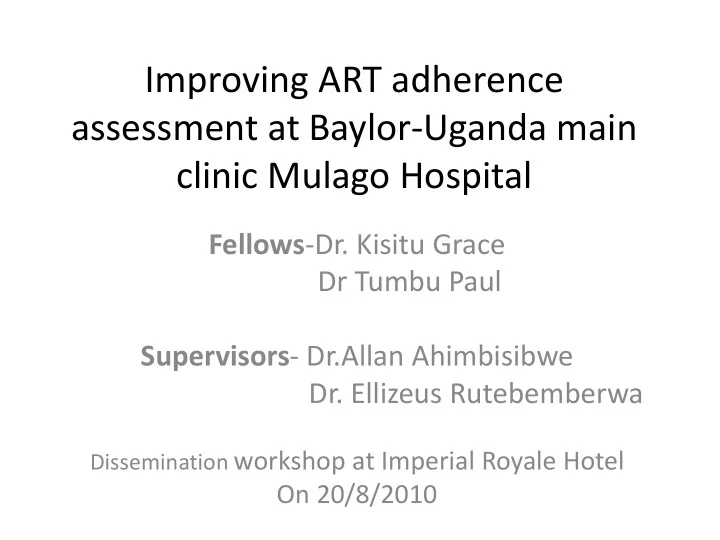

Improving ART adherence assessment at Baylor-Uganda main clinic Mulago Hospital Fellows -Dr. Kisitu Grace Dr Tumbu Paul Supervisors - Dr.Allan Ahimbisibwe Dr. Ellizeus Rutebemberwa Dissemination workshop at Imperial Royale Hotel On 20/8/2010
Introduction • Baylor provides HIV care & treatment services to children, adolescents and adults • Active patients ~ 4,800 • About 55% are on ART • CQI project was undertaken to improve ART adherence assessment
Problem identification • Brainstorming was done during a routine CME • Ten Quality Improvement indicators were subjected to a voting process : a) ART adherence f) CD4 monitoring assessment g) ART eligibility b) Continuity of care h) Septrin prophylaxis c) TB screening i) support counseling d) Growth monitoring j) Patient waiting time e) Access to ITNs
Problem identification • Theme selection process prioritized ART adherence assessment for the improvement
Problem statement and Justification • All patients on ART should be assessed for adherence • By Sept 2009, 47% of clients on ART where not assessed for adherence • This can lead to: – Patient/provider complacency – poor ART adherence – treatment failure – poor quality of life
Baseline situation % patients on ART not assessed for adherence Series1, Sept, 47 Series1, May, Series1, June, 37 37 percentage Series1, April, 26 Months /2009
Project objectives General objective: • To improve adherence assessment among patients receiving ART Specific objectives: • To reduce the proportion of patients on ART in Baylor main clinic who do not receive complete adherence assessment from 47% to 15% by March 2010 • To identify the factors contributing to the non-assessment of adherence among patients receiving ART • To develop and implement practical solutions to the factors contributing to the non-assessment of adherence among patients receiving ART
Project implementation • Started with the problem analysis which was done in 2 parts i. Stratification of the problem by use of a pareto chart ii. Cause-effect analysis by use of a fish-bone diagram
Pareto chart Causes of none or incomplete ART adherence assessment cumulative %, inappropriate/ no appointment given., 100 cumulative %, appropriate tool, but incomplete assessment, 71 cumulative %, inappropriate tools used, 40 % of cases not assessed for ART adherence cumulative %
Cause-effect analysis Category Root causes Tools & appointments - Multiple tools & multiple appointments Patients -Not aware of need for assessment -Some on Syrup medicines Patient flow -multiple service points Clinicians -not using scheduling guides Reception nurse -inserting wrong visit tools into patient charts
Countermeasure matrix Root cause Practical solution - Multiple tools & multiple Reduce visit tools & adopt those appointments that provide for assessment -Patients not aware of need for -Increase awareness through H/E assessment -Some patients on syrups - Switch to pills (FDC’s) multiple service points -harmonize service points Complex scheduling guides for -revise and make simpler clinicians scheduling guides - Develop appointment cards Inserting of wrong visit tools into -sensitize nurse on insertion of the patient charts at reception correct tools
Two practical solutions were not implemented: • Development of patient appointment cards • Revision of scheduling guidelines for clients Project follow-up was done monthly by analyzing data on adherence assessment performance 40 patient files were assessed monthly, in total 200 files were analyzed during the course of implementation
Project outcomes
Proportion of patients on ART not assessed for adherence Series1, Sep-09, BEFORE AFTER 47 INTERVENTION Series1, Jun-09, Series1, May-09, P 37 37 E R Series1, Apr-09, C Series1, Nov, 25 26 E Series1, Dec-09, N TARGET 17 T Series1, Mar-10, Series1, Feb-10, Series1, Jan-10, A 12 12 10 G E TIME
Lessons learnt. • Team work is key to successful QI project implementation • Simple practical solutions can help improve health care quality without extra financial burden to the program • Not all solutions in quality improvement are as effective as may be expected but through continuous innovation the most effective countermeasure may be attained
Lessons learnt • A single practical solution may have a big impact on its own to influence project outcome • Identification of the true root causes of a problem is critical for QI project development • The CQI project findings can be used to validate the organizations M&E reports
Challenges • Two of the proposed counter measures were not implemented for reasons below: – Development of patient appointment cards – Revision of the patient scheduling guides • The records system was upgraded to the electronic medical records (EMR) system shortly after the project ended. – No chance to further observe their QI innovation for sustained improvement in adherence assessment
Challenges • The process of ongoing data collection and analysis was tedious – carried outside official working hours
Conclusion/Next steps • We managed to reduce the proportion of patients not assessed for ART adherence from 47% to 12%, surpassing our target of 15% • • Apply the same QI principles to address the remaining problems • Support the QI programs in other Baylor supported clinics
Acknowledgement • The Management and staff of Baylor Uganda • The Supervisors • MUSPH-CDC fellowship program • The CQI team • CQI fellows
Recommend
More recommend